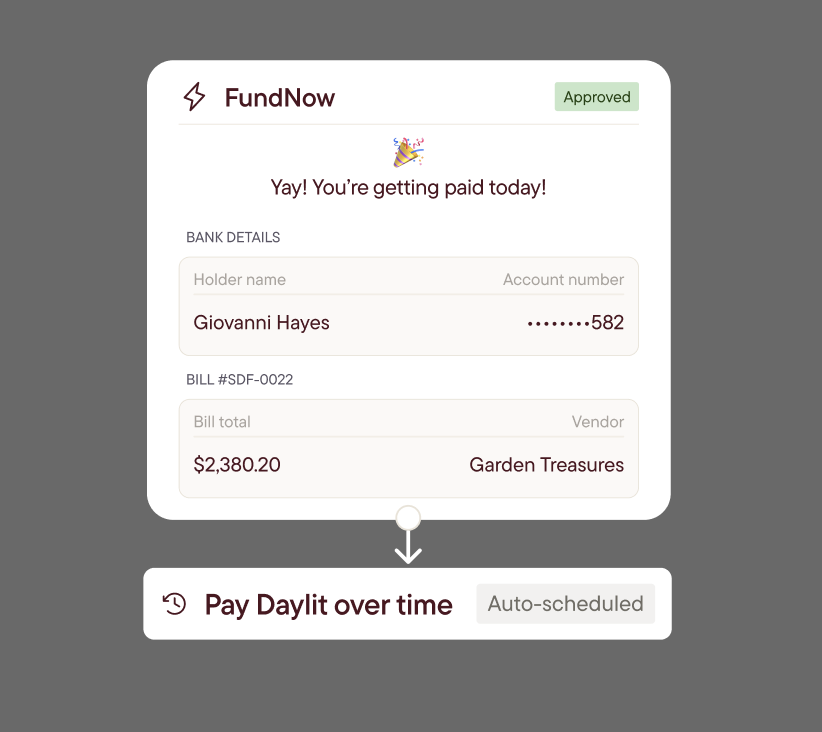It was 4:30 pm on a Friday, and we had just hung up with one of our favorite customers.
A mid-sized distributor called us to ask a few questions about their loan account before drawing some cash. At the very end, almost as a throwaway comment, they mentioned how, “yet again….,” their largest account was eight weeks late on payment.
We dug a little deeper.
Payroll was on Monday. Once again, they had stared, powerless, as a vendor discount just evaporated. In the background of the call, an analyst was spelunking through an email thread trying to find a promise‑to‑pay from “last month, I think.” They had a new hire set to start on Monday. They had spent the week debating whether to pull the offer, while praying the payment would come in, and coming to us for some extra cash to ease some of the stress.
They weren’t blowing up. They were just…slowing down—death by one thousand paper cuts.
We’d run a B2B lending business for years and recognized the pattern instantly: good operators getting punished by slow pay, forced to draw on credit at the worst moment. Nothing dramatic - just a payback cycle that stretched too long and quietly eroded growth.
After we hung up, Jerry looked at me and said, “I bet we can fix this.”
That was the moment Daylit began to take the shape it has today.
The Pattern We Couldn’t Ignore
Running a lending book teaches you two truths very quickly. First, most buyers can pay; second, many won’t pay now without the right nudge. We underwrote their ability to pay for a living – bank‑like signals, seasonality, concentration, and macro-economic variables. But the biggest swings in real‑world outcomes came from willingness: response latency, who actually approves payments, whether a promise‑to‑pay sticks, and the small frictions that turn Net 30 into Net 45.
Behavior kept undercutting policy.
We’d see the same movie over and over. A conscientious finance lead sends the standard reminder into a dark void. A second email - more formal, “as per our terms.” A note in a spreadsheet. A call when the invoice is already late. Eventually, a discount to shake loose cash, or a draw on the line. The relationship takes a tiny hit each time. Multiply by dozens of accounts, and you’re spending your mornings managing anxiety instead of managing cash.
You don’t want to rock the boat with your customers. Some even justify the mindset of “generous terms keep them coming back.”
Frankly, it all seemed like a crutch business leaders relied on.
Jerry and I asked a simple question: What would it take to make “when will we get paid?” a knowable answer rather than a monthly blind forecast?
We didn’t want another dashboard. We didn’t want to outsource relationships to a blunt collector. We wanted intelligence in the loop—patient, polite, persistent—and we wanted financing rails that appeared exactly when a customer couldn’t (or wouldn’t) move.
The Lunch That Set the Course
We sketched the product we wished our lending clients had:
- A single source of truth for the invoice history. Calls, emails, texts, notes, promise‑to‑pay history, dispute context—everything in one place so the story couldn’t evaporate between systems.
- Multi‑modal outreach. Use the channel that works: voice for nuance, email for summary and attachments, SMS for high‑friction, low‑effort confirmations (“Is this the right remit address?”).
- Excel‑native by design. Live data in the cells where finance actually works. No “please log into our portal” speeches. Your pivot tables should light up with fresh reality, not stale exports.
- Built‑in liquidity. If a customer won’t budge, the system should present options—payment plans, factoring, dynamic discounting, or a draw right from the alert. Not as an afterthought. Not as a panic button.
We looked at the napkin and wrote a name across the top: Receivables Intelligence—RI for short.
Early Days: Scrappy Agents and Real Conversations
The prototype was embarrassingly simple. It read inbox threads, matched them to invoices, and proposed the next step based on prior events. If a buyer typically responded to a short text before lunch, the agent suggested that. If a promise‑to‑pay was due Friday, the agent scheduled a confirmation on Thursday morning—specificity beats “sometime this week.”
We wired it to a basic call stack so it could schedule and log calls, then synced every action back into a single worksheet. It wasn’t fancy. It didn’t need to be. In the first week, we watched a finance manager avoid a two‑day email chase by sending a 12‑second text message to confirm a bank detail. In the second week, we watched a dispute resolved when the agent surfaced the exact line item that had confused AP—right in the thread.
What surprised us most was the tone. Collections didn’t feel like collections when the conversation was timely, specific, and respectful. Buyers defaulted to the path of least resistance; our job was to make “pay now” the smoothest path.
Ability vs. Willingness (and Why That Distinction Matters)
Our lending background had trained us to read ability. Receivables Intelligence forced us to quantify willingness. We started labeling signals:
- Reliability of promises. Does “Friday” mean Friday, or “the next Friday we remember”?
- Channel response patterns. Who answers a call versus an email, and at what hour?
- Dispute propensity. Are certain SKUs or locations magnets for confusion?
- Tone and timing. Do responses get faster or shorter as invoices age?
The more we learned, the more the agents adapted. If a buyer went dark after a long email, the agent switched to a crisp summary with a single actionable line. If a contact changed, the agent hunted for the approver rather than the inbox alias. And when the invoice story signaled liquidity issues (not willingness), the agent offered a plan rather than more nudges.
Behavioral economics backed what we saw. A nominal late fee—$10, $25—often accelerated payments not because of the dollars, but because it introduced a meter. The Pain of Paying flipped in our favor. Availability Bias worked, too: staying present with helpful, non‑naggy communication kept our customers top‑of‑mind when the AP stack was overflowing.
None of this felt like wizardry. It felt like being human at scale.
The First Win That Made Us Sure
One of our earliest users was a Midwest-based distributor with a tight team and a tighter cash forecast. Their DSO had inched from the high 30s into the high 40s—nothing catastrophic, but enough to make Friday mornings a little more uncertain.
We turned on RI with just three plays: (1) pre‑due confirmations over the buyer’s preferred channel, (2) promise‑to‑pay captures with specific dates, and (3) one‑click payment plan offers for invoices past 40 days. Two months later, the “red list” on their sheet had fewer names. The finance lead told us the real change wasn’t the average DSO—it was the disappearance of fire drills. “I start my day with a plan instead of a pit,” she said. They didn’t hire a collector. They hired a salesperson.
That’s when Jerry and I knew we were working on the right problem.
What We Built (Because the Journey Demanded It)
We didn’t set out to build a robot collector. We set out to build a teammate who never loses the thread, always chooses the right channel, and offers liquidity with tact.
- Intelligence first. Every customer and invoice has a single invoice narrative. No more reconstructing context from CRMs, inboxes, and “I think we called them last Thursday.” The agent remembers and learns.
- Multi‑modal by default. Voice for nuance, email for documentation, SMS for speed. The agent picks the lane that keeps goodwill intact and time‑to‑cash short.
- Excel‑native. Your universe is still your workbook. Aging buckets update live. Promise‑to‑pay dates are reflected in your cash forecast. Exception lists are actual filters, not a login page.
- Built‑in liquidity. Factor it. BNPL it. Offer a plan. Or draw from credit right from the alert. The agent presents options only when they make sense in terms of the relationship and mathematics.
We kept repeating one phrase to the team: help operators operate with certainty. That, more than any metric, is the point.
The Philosophy Underneath
Jerry likes to say, “Collections is diplomacy with a backbone.” I agree. Ray Kroc built McDonald’s by trusting suppliers and paying fairly; the goodwill was repaid with reliability that powered scale. We want the same long‑term view for our customers and their customers. Good relationships aren’t an argument against timely payments; they’re the reason for them. A steady cadence, specific commitments, and a few thoughtful nudges keep the partnership strong.
We also believe tools should live where people already work. For finance, that’s Excel. It’s fast, transparent, and auditable. We brought the data to the spreadsheet, not the spreadsheet to our system. And we believe financing should be a carrot, not a cliff—available when needed, not dangled as leverage.
Finally, small seams create big leaks. The “just resend the invoice” email, the “who has bank permissions?” back‑and‑forth, the “we pay on Thursdays” nuance that only one person remembers—Receivables Intelligence exists to close those seams.
What This Is Not
Receivables Intelligence is not a collection agency in new clothes. It’s not a black box that demands your trust while hiding its methods. And it’s not an excuse to fire the people who know your customers best.
RI gives those people leverage: context at their fingertips, the right play for each account, and financing options that prevent an awkward conversation from becoming a strained relationship. It trades drama for discipline.
How It Works (In the Flow of a Real Week)
- Monday: The agent syncs your latest aging, enriches contacts, and flags invoices that need pre‑due confirmations. It schedules two short calls and drafts three crisp emails that mirror your brand voice.
- Tuesday: Two buyers reply to SMS confirmations; one updates a remit detail the agent asked about. An approver link is captured in the thread and surfaces in your workbook.
- Wednesday: A buyer who often slips gets a specific ask: “Can you confirm payment on Friday, November 14?” They tap confirm. The date is automatically plugged into your forecast.
- Thursday: One invoice drifts into dispute territory. The agent proposes a two‑installment plan that matches the buyer’s history. They accept with one click; your sheet updates.
- Friday: You review an exception list, not a fire list. Where liquidity makes sense and options are already queued—factor, discount dynamically, or draw. You choose math, not adrenaline.
That’s a week with fewer unknowns and more signals. That’s what we wanted when we started this.
Why We Started This Business
We didn’t start Daylit because we love receivables. We started it because we hate waste: wasted mornings, wasted goodwill, wasted growth. We were tired of watching thoughtful operators play calendar chess with incomplete information while carrying the float for buyers with longer attention spans than approval chains.
Jerry and I also had a bias we couldn’t shake: the belief that the gap between knowing and hoping is where the best businesses are built. In lending, that gap looked like guesswork around repayment dates. In operations, it looked like spreadsheets stitched together with memory. In both, it looked like anxiety masquerading as a process.
Receivables Intelligence is our attempt to close that gap. It’s the product we wished our lending clients had, the teammate we wished every finance lead could hire, and the system we wished existed every time a good company slowed down for no good reason.
An Invitation
If you’re a manufacturer, distributor, contractor, staffing firm, or a vertical SaaS serving any of the above, you know this terrain. You don’t need more dashboards. You need fewer unknowns. You don’t need harsher emails. You need a polite closer who remembers every promise and shows up with financing only when it helps.
Operate with certainty. That’s the promise Jerry and I built Daylit to keep.
If this resonates, let’s talk. DM us for an early look. We’d love to show you how a stitched invoice thread, a smarter cadence, and liquidity on tap can turn “we hope” into “we know”—and give you your Fridays back.




